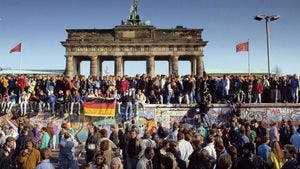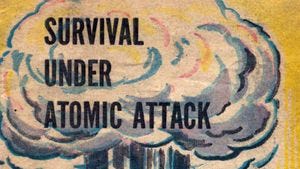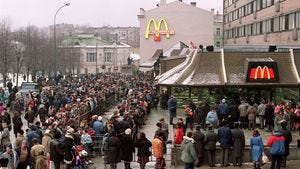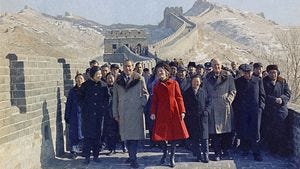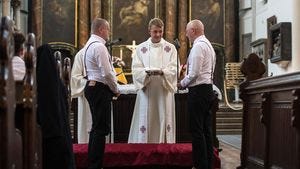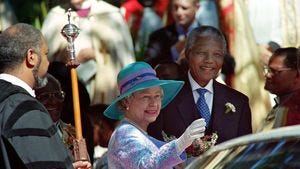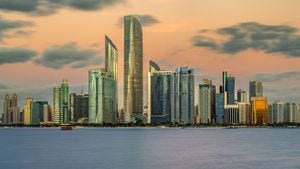The Second Elizabethan Era: Geopolitics in a Changing World
At the beginning of Elizabeth II’s reign, colour-coded maps provided a quick guide to the far-flung colonial possessions of Europe’s empires. By the 1960s and ’70s, however, nationalist independence movements had helped bring about widespread decolonizationof British, French, Dutch, Belgian, and Portuguese possessions (especially in Africa), and the British Empire, on which, it was said, “the sun never set,” had transformed into the Commonwealth, a free association of sovereign states for whom the British monarch was only the symbolic head. By the 2020s someCaribbean states, following the lead ofBarbados (newly declared a republic), appeared ready to cut that tie too, another marker of the stunning array of changes that unfolded globally during the queen’s long tenure on the throne.
The Cold War
The Cold War dominated international affairs for much of the Second Elizabethan Era. At its symbolic centre for decades was Germany, where theBerlin Wall was the tangible manifestation of the metaphoric Iron Curtain that sealed off communist eastern Europe after World War II. In 1989, as the Soviet Union loosened its grasp on the Eastern bloc, the wall fell. The next year East Germany and West Germany united again as a single country.
The Threat of Nuclear War
Because of the proliferation of increasingly destructive weapons, the threat of nuclear Armageddon hung over much of Elizabeth’s reign, never more so than during the Cuban missile crisis of 1962. Duck-and-cover drills and fallout shelters were, for a time, part of life, but so too were ongoing arms control talks, such as the Strategic Arms Limitation Talks (SALT) of the late 1960s and ’70s and the Reykjavík summit of 1986, between U.S. President Ronald Reaganand Soviet Premier Mikhail Gorbachev, which many historians consider a turning point in the Cold War.
From Stalin to Putin
When Elizabeth became queen, Joseph Stalin was still in charge of the Soviet Union. By the end of 1991, in the wake of the changes wrought by Gorbachev’s policies of glasnost and perestroika, the Soviet Union had dissolved and theEastern bloc had crumbled. The resulting so-called New World Order brought Russian natural gas to western European homes and found Starbucks andMcDonald’s flourishing in a Moscowwhere once there had been a choice of only two flavours of ice cream. But the ascendance of the dictatorial Vladimir Putin as Russia’s leader brought a new era of repression and expansionism that led to the Russian invasion of Ukraine in February 2022.
The Rise of China
Throughout the Second Elizabethan Era, the People’s Republic of China was a rising communist giant, for much of that time isolated from the West. The Cold War dynamic was changed significantly by the Sino-Soviet split in 1960. In the era of detente, U.S. President Richard Nixon played the U.S.S.R. and China off against each other, making a historic visit to China in 1972 that led to the reestablishment of official Chinese-U.S. relations. By the 21st century China had transformed into an aggressive economic superpower whose products blanketed the globe. In 1997 it assumed control of the longtime British colony of Hong Kong.
A United Europe, a British Exit
Europe also saw much change during Elizabeth’s reign. Devastated by World War II, western Europe and its economy bounced back quickly, largely because of the support provided by the U.S. Marshall Plan. The founding of the European Coal and Steel Community in 1952 began the process by which western European countries that had been rivals for centuries (most notably France and West Germany) pursued ever-closer political and economic ties that eventually led to the establishment in the early 1990s of the European Union. Britain, which joined the group in 1973, was the first to leave, officially achieving so-called Brexitin 2020.
Social Changes
Not surprisingly, society in much of the world underwent massive changes during the Second Elizabethan Era. World War II had brought more and more women into the workforce, increasingly in positions traditionally reserved for men, not least as corporate executives and the elected heads of government—from India’s Indira Gandhi, Israel’s Golda Meir, and Britain’sMargaret Thatcher to New Zealand’sJacinda Ardern and Liberia’s Ellen Johnson Sirleaf. Restrictions on abortionwere eased in countries throughout the world, though in 2022 the U.S. Supreme Court removed the constitutional right to abortion by overturning the decision inRoe v. Wade (1973). Homosexuality, illegal in many countries when Elizabeth took the throne, was widely normalized through the efforts of the gay rights movement. By 2019 same-sex marriagehad become accepted in the law of the land in more than two dozen countries.
Jim Crow racial segregation thrived in the American South in the 1950s and ’60s, but the U.S. Supreme Court’s Brown v.Board of Education of Topeka (1954) ruling, the Civil Rights Act (1964), and theVoting Rights Act (1965) profoundly altered the social order. In 2008 Barack Obama was elected the first Black U.S. president. Legislation that sanctionedapartheid remained in place in South Africa until the 1990s, but in 1994 Nelson Mandela became that country’s first Black president. In 1997 Kocheril Raman Narayanan became the first member of aScheduled Caste (formerly called untouchables) to serve as India’s president.
The Transformation of Korea and Japan
As Elizabeth took the throne, U.S. and other UN forces were fighting the Korean War to “contain” communism. South Korea had a war-ravaged, barely industrialized economy that ran on foreign aid and subsistence agriculture, and Japan was rebuilding its devastated cities and still under American occupation. Today they are among the richest and most technologically advanced countries in the world.
Revolution
Revolution was in the air throughout Elizabeth’s reign. In Hungary (1956) rebels sought to throw off or at least reform communism. In the Fidel Castro-led Cuban Revolution (1953–59) Marxismwas embraced. The Iranian Revolution(1978–79) toppled the monarchy ofMohammad Reza Shah Pahlavi and replaced it with an Islamic republic guided by Ayatollah Ruhollah Khomeini. In Czechoslovakia the Prague Spring(1968) stalled, but the Velvet Revolution(1989) succeeded. In Ukraine (2004–05) the Orange Revolution overturned a rigged presidential election. The wave of pro-democracy protests known as theArab Spring (2010–11) began with Tunisia’s Jasmine Revolution and included the Egypt Uprising (2011),Yemen Uprising (2011–12), and Libya Revolt (2011).
The Middle East
In the Middle East, foreign control of petroleum resources disappeared during the Second Elizabethan Era, replaced by nationalized industries and OPEC. In 1958 impoverished Abu Dhabi—then a British protectorate—discovered oil with the aid of British Petroleum. The United Arab Emirates, born in 1971 after British withdrawal, became one of the wealthiest countries in the world by the time of Elizabeth’s death, its rapid rise driven by Abu Dhabi and its Abu Dhabi National Oil Company.
At the centre of events in the region was the Arab-Israeli conflict. Britain’s colossal missteps in the Suez Crisis (1956) meant that it no longer was a player. The Six-Day War (1967) and Yom Kippur War(1973) shaped the landscape on which a mutually acceptable two-state solutionwas pursued for decades against a backdrop of sporadic violence and popular uprisings such as the intifadah. Progress came through the Camp David(1978) and Oslo (1993) accords, but at the end of the era lasting peace still seemed a long way off.
A rivalry developing between the Shiʾiand Sunni sects of Islam also was central to the struggle for dominance in the Middle East. After the Iran-Iraq War(1980–88), Iraqi leader Saddam Hussein’s invasion of Kuwait prompted a U.S.-led response in the Persian Gulf War (1990–91). In 2003 another U.S.-led coalition came, this time looking for weapons of mass destruction it never found, though the Iraq War dragged on until 2011. TheSeptember 11, 2001, terrorist attacks on the United States by al-Qaeda, the Islamist militant organization founded byOsama bin Laden, resulted in another U.S.-led incursion and the prolongedAfghanistan War, whose end preceded Elizabeth’s death by only months.
By the 21st century deadly terrorist attacks by a variety of politically motivated groups had become all too familiar across the globe. Of the 9/11 attacks Elizabeth had stated, “But nothing that can be said can begin to take away the anguish and the pain of these moments. Grief is the price we pay for love.”
Source:Britannica
The Editors of Encyclopaedia BritannicaThis article was most recently revised and updated by Jeff Wallenfeldt.



